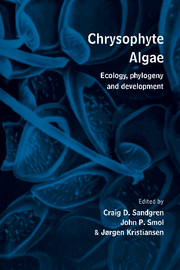Book contents
- Frontmatter
- Contents
- Preface
- List of contributors
- 1 History of chrysophyte research: origin and development of concepts and ideas
- Part I Phylogeny, systematics and evolution
- Part II Development, physiology and nutrition
- 5 Comparative aspects of chrysophyte nutrition with emphasis on carbon, phosphorus and nitrogen
- 6 Mixotrophy in chrysophytes
- 7 Biomineralization and scale production in the Chrysophyta
- 8 Immunological and ultrastructural studies of scale development and deployment in Mallomonas and Apedinella
- Part III Ecology, paleoecology and reproduction
- Part IV Contributed original papers
- Index of scientific names
- Subject index
8 - Immunological and ultrastructural studies of scale development and deployment in Mallomonas and Apedinella
Published online by Cambridge University Press: 05 March 2012
- Frontmatter
- Contents
- Preface
- List of contributors
- 1 History of chrysophyte research: origin and development of concepts and ideas
- Part I Phylogeny, systematics and evolution
- Part II Development, physiology and nutrition
- 5 Comparative aspects of chrysophyte nutrition with emphasis on carbon, phosphorus and nitrogen
- 6 Mixotrophy in chrysophytes
- 7 Biomineralization and scale production in the Chrysophyta
- 8 Immunological and ultrastructural studies of scale development and deployment in Mallomonas and Apedinella
- Part III Ecology, paleoecology and reproduction
- Part IV Contributed original papers
- Index of scientific names
- Subject index
Summary
Introduction
The diversity and morphology of scales and scale-like structures (e.g., spines, spine-scales, bristles) are remarkable among the different protistan groups, and the mechanism of their assembly and deployment can vary considerably (for review, see Romanovicz 1981). Arguably the most spectacular scale-bearing algae are found in the division Chrysophyta, which includes the organisms under investigation here: Mallomonas splendens (G.S. West) Playfair em. Croome, Dürrschmidt & Tyler (Synurophyceae) and Apedinella radians (Lohmann) Campbell (Pedinellophyceae). These two species collectively exhibit a wide range of surface features, some of them unique, and are excellent experimental systems for studying the development of scales and scale cases.
A number of cytological techniques have been used to investigate scale formation and development, most notably scanning and transmission electron microscopy. The formation of synurophycean scales (including the scale-like ‘bristles’ of Mallomonas) has been followed in several species at the ultrastructural level (e.g., Mignot & Brugerolle 1982; Brugerolle & Bricheux 1984). The exact manner of scale deployment onto the surface, however, is unknown, although two possible mechanisms have been put forward (Leadbeater 1990; Siver & Glew 1990). Recently, in vivo observations of bristle secretion and deployment in M. splendens have been made using image-enhanced video microscopy, and corroborated ultrastructurally with thin-sectioned material (Beech et al. 1990).
The development of immunocytochemical techniques has extended our knowledge of the cytoskeletal components active in these processes as well as the nature and role of surface molecules associated with the scale layer.
- Type
- Chapter
- Information
- Chrysophyte AlgaeEcology, Phylogeny and Development, pp. 165 - 178Publisher: Cambridge University PressPrint publication year: 1995
- 2
- Cited by

